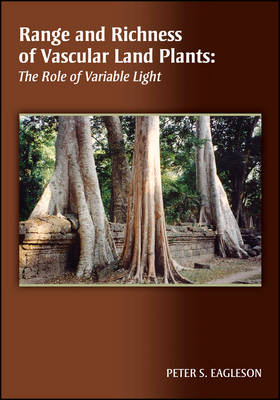
Range and Richness of Vascular Land Plants
American Geophysical Union (Verlag)
978-0-87590-732-1 (ISBN)
- Titel z.Zt. nicht lieferbar
- Versandkostenfrei
- Auch auf Rechnung
- Artikel merken
Published by the American Geophysical Union as part of the Special Publications Series.
This is a research monograph and not a textbook. Here I demonstrate analytically how the observed, opposing, latitudinal gradients in the average range and richness of local vascular land plant species are (outside the moist-tropical zone, at least) driven primarily by the local temporal and spatial variability of shortwave radiative flux at the canopy top. (The term "richness" as used here means the local number of different vascular land plant species unlimited by the size of the area sampled.) The hypotheses are simplistic but are nevertheless convincingly accurate in extratropical latitudes when tested against observations over the continental land surfaces of the Northern Hemisphere, the only areas tested here.
Peter S. Eagleson is an American hydrologist. He has taught at the Massachusetts Institute of Technology since 1952 and is currently a Professor Emeritus.
Foreword xi
Preface xiii
Acknowledgments xvii
Part I: Overview 1
Chapter 1: Introduction 3
Historical summary 3
Modeling philosophy 5
Bioclimatic basis for local community structure 7
Range 9
Richness 13
Major simplifications 14
Principal assumptions 15
Principal findings 15
Part II: Local Species Range and Richness 17
Chapter 2: Local Climate: Observations and Assessments 19
Major biomes of North America 19
Growing season 19
Solar radiation 20
Zonal homogeneity 27
Looking ahead 29
Chapter 3: Mean Latitudinal Range of Local Species: Prediction Versus Observation 31
Introduction and definitions 31
Range of local mean species as determined by local distributions about the mean 32
Theoretical estimation of the range with climatic forcing by SW flux only 36
Range of local modal species versus mean of local species’ ranges 39
Probability mass of the distribution of observed local species 42
Analytical summary for climatic forcing by SW flux only 43
Point-by-point estimation of range versus observation for North America 45
A thought experiment on the variation of SW flux in an isotropic atmosphere 49
Range of modal species at maxima and minima of the SW flux 51
Gradient estimation of range versus observation for North America 52
Point-by-point estimation of range versus observation for the Northern Hemisphere 55
Gradient estimation of range versus observation for the Northern Hemisphere 60
Low-latitude smoothing of range by latitudinal averaging of the growing season 62
Range as a reflection of the bioclimatic dispersion of species 63
A high-latitude shift in bioclimatic control from light to heat? 65
Extension of these range forecasts by use of multiple forcing variables 68
A look ahead 68
Chapter 4: Richness of Local Species: Prediction Versus Observation 69
Introduction 69
From continuous to discrete distribution of local species 72
Local SW flux as a stationary Poisson stochastic
process 73 Distribution of C3 species–supporting radiation intercepted in a growing season 75
Moments of C 3 species–supporting radiation intercepted in a growing season 77
Moments of the number of C3 species–supporting cloud events in a growing season 78
From climatic disturbance to C3 species germination 79
Parameter estimation 80
Predicted potential richness versus observed richness 82
The theoretical tie between range and richness 84
Part III: Recapitulation 85
Chapter 5: Summary and Conclusions 87
Precis 87
Mathematical approximations in range calculation 89
Evaluation of range prediction 90
Evaluation of richness prediction 92
Finis 93
Part IV: Appendices: Reductionist DarwinianModeling of the Bioclimatic Function for C3 Plant Species 95
Appendix A: The Individual C3 Leaf 97
Photosynthetic capacity of the C3 leaf 97
Mass transfer from free atmosphere to chloroplasts 99
Assimilation modulation by leaf temperature and ambient CO2 concentration 104
Exponential approximation to the C3 photosynthetic capacity curve 104
Potential assimilation efficiency of C3 leaves 105
The state of stress 107
Darwinian operating state of the individual C3 leaf 107
The univariate bioclimatic function at leaf scale 108
Appendix B: The Homogenous C3 Canopy 111
Idealized geometry of the leaf layer 111
Darwinian heat proposition 113
Vertical flux of radiation in a closed canopy 113
C 3 species parameters 116
Bioclimatic function at canopy scale 117
Local evolutionary equilibrium: An hypothesis 118
Appendix C: Evaluation of the Evolutionary Equilibrium Hypothesis 121
The equilibrium hypothesis at leaf scale 121
The equilibrium hypothesis at local canopy scale 121
Summary 125
Notation 127
Glossary 137
Bibliography 141
Additional Reading 147
Author Index 149
Subject Index 151
| Reihe/Serie | Special Publications |
|---|---|
| Sprache | englisch |
| Maße | 178 x 255 mm |
| Gewicht | 372 g |
| Themenwelt | Naturwissenschaften ► Biologie ► Botanik |
| Naturwissenschaften ► Biologie ► Ökologie / Naturschutz | |
| Naturwissenschaften ► Geowissenschaften ► Geologie | |
| Naturwissenschaften ► Geowissenschaften ► Geophysik | |
| ISBN-10 | 0-87590-732-6 / 0875907326 |
| ISBN-13 | 978-0-87590-732-1 / 9780875907321 |
| Zustand | Neuware |
| Haben Sie eine Frage zum Produkt? |
aus dem Bereich


